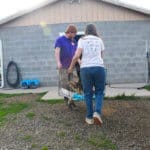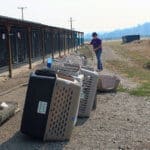Overpopulation is a dominant theme this year. We used to average 30 – 35, maybe 40, residents, plus 20 or so in foster. There was no Sanctuary. Now, the Adoption Center routinely houses 60 dogs, Sanctuary numbers have exceeded 90 individuals, and fosters have their hands full. This week, I asked Adoption Center Manager Rick Formanek and Assistant Manager Ari Strasser what it’s like to be constantly operating at full capacity.
Full capacity, the new normal
When I arrived at the office, AliCarmen Carico was helming the front desk with special needs puppy, Gabby.
For his part, Rick was reviewing his three most recent urgent messages. The first was about three abandoned moms and their litters totaling at least 20 puppies in the Vistas. He said Rescue Ranch was going to try to get out to catch them and spay the moms.
The second one was about four, four-month-old puppies in a mobile home park in South Yreka. The third message involved the surrender of a senior 13- or 14-year-old teacup Chihuahua. The caller’s landlord doesn’t allow pets.
Rick said they were still deciding where the potential new intakes would land: Sanctuary? Foster? Adoption Center?
Ari added that he had vaccinated 15 more dogs the day before: eight nine-week-old puppies, five eight-month-old puppies, and their parents. The dogs were going to stay in place as fosters, but he was working on getting at least the mom and her eight-month-old daughter on upcoming RRAAP runs. Rescue Ranch will try to help home and spay/neuter the puppies when they’re ready.
How does the dramatic increase impact every day operations?
Ari explained that, while space is a factor, so is time. For example, although some dogs do well in appropriate outdoor enclosures, most sleep indoors. In the morning, they eat breakfast and then go out to the yards while staff clean their kennels. Later in the day, the dogs come back inside, eat dinner, and settle for the night.
Moving 60 individual dogs is not a quick process. In addition to the two-minute walk each way, the techs must take the time to reinforce good manners. Waiting for excited dogs to calm down before opening the kennel door can be time consuming. Each dog learns on their own schedule. All of the dogs also need enrichment, play, socialization, leash training, vetting, etc. Moreover, staff must acquire and maintain dog handling skills. They need time to complete training modules in safe dog handling, avoiding dog fights, footwork, etc.
Another issue is that more dogs require more caregivers. The Adoption Center now has five full-time and two part-time kennel techs, but both Rescue Ranch facilities operate with minimal staff. They’re grateful for the help of committed volunteers.
Working at full capacity and accepting the current rate of increase is not a long-term strategy for combatting overpopulation. What’s required are more adopters, education, responsible dog ownership, easy access to affordable spay/neuter, and more pet-friendly housing options.
But until we have those things, Rescue Ranch will continue doing its best to provide quality care and save lives.
























